赣南师范学院本科生毕业论文写作模板
本科毕业论文标准范文
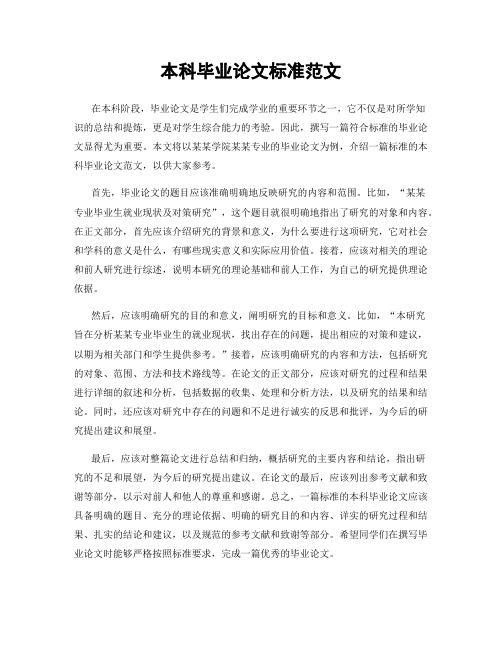
本科毕业论文标准范文在本科阶段,毕业论文是学生们完成学业的重要环节之一,它不仅是对所学知识的总结和提炼,更是对学生综合能力的考验。
因此,撰写一篇符合标准的毕业论文显得尤为重要。
本文将以某某学院某某专业的毕业论文为例,介绍一篇标准的本科毕业论文范文,以供大家参考。
首先,毕业论文的题目应该准确明确地反映研究的内容和范围。
比如,“某某专业毕业生就业现状及对策研究”,这个题目就很明确地指出了研究的对象和内容。
在正文部分,首先应该介绍研究的背景和意义,为什么要进行这项研究,它对社会和学科的意义是什么,有哪些现实意义和实际应用价值。
接着,应该对相关的理论和前人研究进行综述,说明本研究的理论基础和前人工作,为自己的研究提供理论依据。
然后,应该明确研究的目的和意义,阐明研究的目标和意义。
比如,“本研究旨在分析某某专业毕业生的就业现状,找出存在的问题,提出相应的对策和建议,以期为相关部门和学生提供参考。
”接着,应该明确研究的内容和方法,包括研究的对象、范围、方法和技术路线等。
在论文的正文部分,应该对研究的过程和结果进行详细的叙述和分析,包括数据的收集、处理和分析方法,以及研究的结果和结论。
同时,还应该对研究中存在的问题和不足进行诚实的反思和批评,为今后的研究提出建议和展望。
最后,应该对整篇论文进行总结和归纳,概括研究的主要内容和结论,指出研究的不足和展望,为今后的研究提出建议。
在论文的最后,应该列出参考文献和致谢等部分,以示对前人和他人的尊重和感谢。
总之,一篇标准的本科毕业论文应该具备明确的题目、充分的理论依据、明确的研究目的和内容、详实的研究过程和结果、扎实的结论和建议,以及规范的参考文献和致谢等部分。
希望同学们在撰写毕业论文时能够严格按照标准要求,完成一篇优秀的毕业论文。
本科大学毕业论文范文模板 本科生毕业论文模板word下载(优秀3篇)-最新
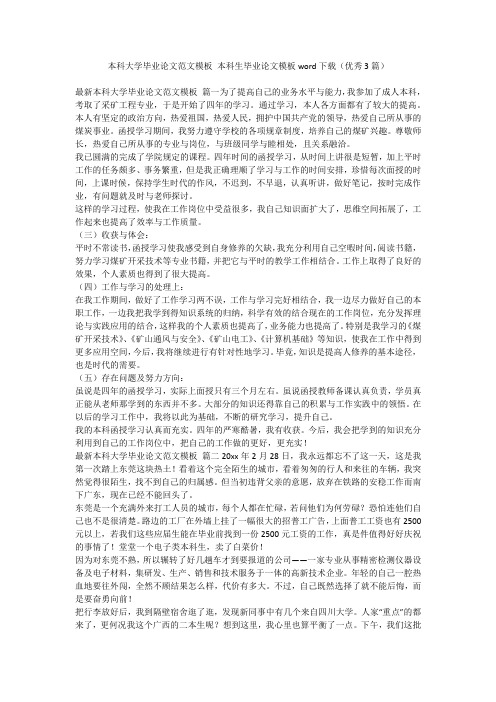
本科大学毕业论文范文模板本科生毕业论文模板word下载(优秀3篇)最新本科大学毕业论文范文模板篇一为了提高自己的业务水平与能力,我参加了成人本科,考取了采矿工程专业,于是开始了四年的学习。
通过学习,本人各方面都有了较大的提高。
本人有坚定的政治方向,热爱祖国,热爱人民,拥护中国共产党的领导,热爱自己所从事的煤炭事业。
函授学习期间,我努力遵守学校的各项规章制度,培养自己的煤矿兴趣。
尊敬师长,热爱自己所从事的专业与岗位,与班级同学与睦相处,且关系融洽。
我已圆满的完成了学院规定的课程。
四年时间的函授学习,从时间上讲很是短暂,加上平时工作的任务颇多、事务繁重,但是我正确理顺了学习与工作的时间安排,珍惜每次面授的时间,上课时候,保持学生时代的作风,不迟到,不早退,认真听讲,做好笔记,按时完成作业,有问题就及时与老师探讨。
这样的学习过程,使我在工作岗位中受益很多,我自己知识面扩大了,思维空间拓展了,工作起来也提高了效率与工作质量。
(三)收获与体会:平时不常读书,函授学习使我感受到自身修养的欠缺,我充分利用自己空暇时间,阅读书籍,努力学习煤矿开采技术等专业书籍,并把它与平时的教学工作相结合。
工作上取得了良好的效果,个人素质也得到了很大提高。
(四)工作与学习的处理上:在我工作期间,做好了工作学习两不误,工作与学习完好相结合,我一边尽力做好自己的本职工作,一边我把我学到得知识系统的归纳,科学有效的结合现在的工作岗位,充分发挥理论与实践应用的结合,这样我的个人素质也提高了,业务能力也提高了。
特别是我学习的《煤矿开采技术》、《矿山通风与安全》、《矿山电工》、《计算机基础》等知识,使我在工作中得到更多应用空间,今后,我将继续进行有针对性地学习。
毕竟,知识是提高人修养的基本途径,也是时代的需要。
(五)存在问题及努力方向:虽说是四年的函授学习,实际上面授只有三个月左右。
虽说函授教师备课认真负责,学员真正能从老师那学到的东西并不多。
师范本科毕业论文范文欣赏(共3篇)

师范本科毕业论文范文欣赏(共3篇)本文从网络收集而来,上传到平台为了帮到更多的人,如果您需要使用本文档,请点击下载按钮下载本文档(有偿下载),另外祝您生活愉快,工作顺利,万事如意!第1篇:地方院校计算机师范本科专业培养模式探索大学4年既长又短,我们时常听到即将毕业的学生感叹:“什么都学了,但好像什么都不会!”。
在高等教育由“精英型”向“大众化”转变的过程中,加强通识教育,实施以“加强基础,淡化专业”为指导思想的“宽口径、厚基础、复合型”的本科人才培养模式,对于扩大学生的知识面,促进学生的全面发展起到了很大的促进作用[1]。
但是,面对日益激烈的就业竞争,如何培养“特长突出”的人才是我们地方院校需要十分重视的一个课题[2]。
计算机师范本科专业面向中小学信息技术课程培养师资,长期以来只注重专业知识的培养而忽略教师职业技能的训练。
本文根据地方院校实际和中小学信息技术师资能力需求,讨论相应的计算机师范本科专业培养模式与课程体系,力图构建合理的专业核心课程,打造第一、二、三课堂协调发展的良好氛围,培养具有一定理论知识、较强实践能力和宽广适应水平的高素质中小学信息技术师资。
1目标定位及其人才培养模式地方院校计算机师范本科专业的培养目标与定位是立足当地、面向全省培养中小学信息技术和中等职业技术教育相关专业师资和教育信息化建设人才,以及地方经济社会发展需要的信息技术应用开发型人才。
中小学信息技术教师无一例外地领导或参与学校网络管理和信息化工作,因此我们提出师范技能与专业技能并重的计算机师范本科专业人才培养模式,即以提高人才培养质量为核心,以实现“零距离就业”为目标,坚持师范技能与专业技能训练4年不断线,培养“崇德行、厚基础、强技能、懂教育”的高级应用型人才。
在人才培养模式改革中,充分注意专业教学内容的实用性与学术性兼顾,不断加强教学条件建设,高度重视能力培养,运用正确的教学方法,制订有效的实施方案,保证较高的人才培养质量。
本科生论文范文(通用7篇)

本科生论文范文1通过这一阶段的努力,我的毕业论文《某某某》终于完成了,这意味着大学生活即将结束。
在大学阶段,我在学习上和思想上都受益非浅,这除了自身的努力外,与各位老师、同学和朋友的关心、支持和鼓励是分不开的。
在本论文的写作过程中,我的导师某某老师倾注了大量的心血,从选题到开题报告,从写作提纲,到一次又一遍地指出每稿中的具体问题,严格把关,循循善诱,在此我表示衷心感谢。
同时我还要感谢在我学习期间给我极大关心和支持的各位老师以及关心我的同学和朋友。
写毕业论文总结报告是一次再系统学习的过程,毕业论文答辩自述的完成,同样也意味着新的学习生活的开始。
我将铭记我曾是一名某某学子,在今后的工作中把某某的优良传统发扬光大。
感谢各位专家的批评指导。
本科生论文范文2通过这一阶段的努力,我的毕业论文《某某某》终于完成了,这意味着大学生活即将结束。
在大学阶段,我在学习上和思想上都受益非浅,这除了自身的努力外,与各位老师、同学和朋友的关心、支持和鼓励是分不开的。
在本论文的写作过程中,我的导师某某老师倾注了大量的心血,从选题到开题报告,从写作提纲,到一次又一遍地指出每稿中的具体问题,严格把关,循循善诱,在此我表示衷心感谢。
同时我还要感谢在我学习期间给我极大关心和支持的各位老师以及关心我的同学和朋友。
写毕业论文总结报告是一次再系统学习的过程,毕业论文答辩自述的完成,同样也意味着新的学习生活的开始。
我将铭记我曾是一名某某学子,在今后的工作中把某某的优良传统发扬光大。
感谢各位专家的批评指导。
本科生论文范文3致谢三年的学习生活即将结束,回顾三年的学习生活,感受颇深,收获丰厚。
在论文的写作过程中,有很多困难,无论是在理论学习阶段,还是在论文的选题、资料查四询、开题、研究和撰写的每一个环节,无不得到导师的悉心指导和帮助。
借此机会我向导师表示衷心的感谢!同时,我要感谢陕西职业技术学院授课的各位老师,正是由于他们的传道、授业、解惑,让我学到了专业知识,并从他们身上学到了如何求知治学、如何为人处事。
本科毕业论文模板范文

摘要:本文以XXX理论为基础,对XXX现象进行了深入研究。
通过对XXX的实证分析,揭示了XXX的内在规律和影响因素,并提出了相应的对策建议。
本文的研究成果对于XXX领域的发展具有重要的理论意义和现实价值。
关键词: XXX理论;XXX;实证分析;对策建议目录:一、引言二、文献综述三、研究方法与数据来源四、实证分析五、结果与讨论六、结论与建议七、参考文献一、引言(一)研究背景随着社会经济的快速发展,XXX现象日益凸显。
XXX不仅关系到XXX领域的发展,也对社会稳定和人民生活产生了深远影响。
为了更好地理解和解决XXX问题,有必要对其进行深入研究。
(二)研究目的与意义本文旨在通过XXX理论的分析框架,对XXX现象进行实证研究,揭示其内在规律和影响因素,为XXX领域的发展提供理论支持和实践指导。
二、文献综述(一)XXX理论概述XXX理论是XXX领域的重要理论之一,其核心观点是XXX。
该理论认为XXX,并提出了XXX。
(二)国内外研究现状近年来,国内外学者对XXX现象进行了广泛的研究。
主要研究方向包括XXX、XXX 和XXX等。
三、研究方法与数据来源(一)研究方法本文采用XXX方法对XXX现象进行研究。
具体包括XXX、XXX和XXX等。
(二)数据来源本研究数据来源于XXX,包括XXX、XXX和XXX等。
四、实证分析(一)变量定义与描述性统计本文选取XXX作为因变量,XXX作为自变量。
通过对数据的描述性统计,分析各变量的分布特征。
(二)模型构建与估计本文采用XXX模型对XXX现象进行实证分析。
通过对模型进行估计,检验各变量之间的关系。
(三)结果分析根据实证分析结果,本文得出以下结论:1. XXX现象与XXX之间存在XXX关系;2. XXX对XXX现象具有XXX影响;3. XXX因素对XXX现象具有XXX作用。
五、结果与讨论(一)结果分析根据实证分析结果,本文对XXX现象进行了深入讨论。
主要结论如下:1. XXX现象的成因复杂,涉及XXX、XXX和XXX等因素;2. XXX现象对XXX领域的发展具有重要影响;3. XXX对策建议对于解决XXX现象具有实际意义。
论文四稿
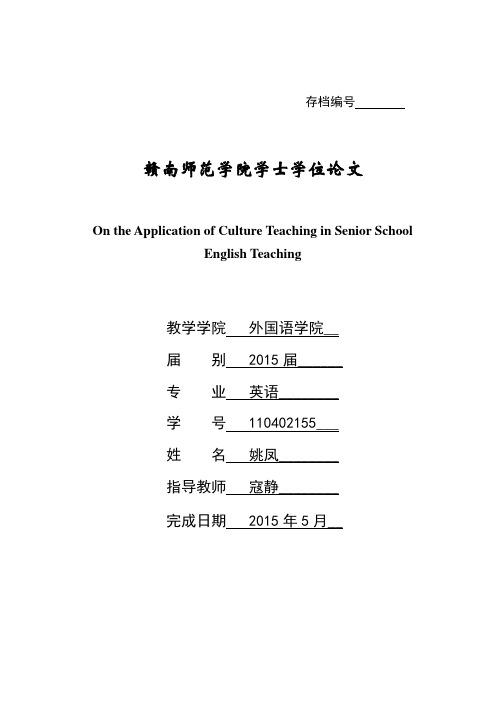
存档编号赣南师范学院学士学位论文On the Application of Culture Teaching in Senior SchoolEnglish Teaching教学学院外国语学院__届别 2015届______专业英语________学号 110402155___姓名姚凤________指导教师寇静________完成日期 2015年5月__作者声明本毕业论文(设计)是在导师的指导下由本人独立撰写完成的,没有剽窃、抄袭、造假等违反道德、学术规范和其他侵权行为。
对本论文(设计)的研究做出重要贡献的个人和集体,均已在文中以明确方式标明。
因本毕业论文(设计)引起的法律结果完全由本人承担。
毕业论文(设计)成果归赣南师范学院所有。
特此声明。
作者专业:作者学号:作者签名:20 年月日ContentsAbstract (ⅰ)Key words ............................................................................................................. ..ⅰIntroduction ............................................................................................................. .1 Chapter Ⅰ Literary Review.. (3)1.1 Language and Culture. .................................................................................. .3 1.2 Language Teaching and Culture Teaching.. (4)1.3 The Theoretical Basis and Practice Foundation of Culture Teaching (5)Chapter Ⅱ Current Situation & Subsistent Problems (7)Chapter Ⅲ The Strategies of Culture Teaching in Senior High English Class (9)3.1 Cultural Knowledge Introduction of Words (9)3.2Cultural Knowledge Introduction of Idioms (10)3.3 Introduction of Oral Communication Culture (11)3.4 Introduction of History and Literary Quotation.................................,,.12 3.5 Introduction of Non-linguistic Knowledge.. (13)Chapter Ⅳ Specific Approaches (14)Conclusion (16)Bibliography (17)Abstract:In recent years, a common sense has been reached in foreign language teaching circles: the ultimate aim of foreign language teaching is to cultivate new talents who can communicate in foreign language in the process of cross-cultural communication. This has been written into the Standards of ordinary senior high school English curriculum(experiment draft). Nevertheless, the reach of consensus never equals to a solution. It is impossible to form the communicative competence if students don’t know any culture knowledge of the English speaking countries. However, as a result of the high school and university entrance exams’ being China’s major way of select talents for a long time, foreign language teaching in China mainly teaches language knowledge and cares much about students’ abilities to take exams, which leads to Chinese foreign language teaching’s lack of culture teaching ability and awareness. After making an introduction about the main contents, this paper illustrates the definition, relevance and significance of language and culture. Then, this paper elucidates language teaching and culture teaching from several respects and discusses about the current situation and subsistent problems on culture teaching in senior high school. Next, this paper offers some possible strategies and specific approaches of culture teaching. In the end, this paper makes a brief conclusion. After realizing the problem clearly and changing progressively in teaching strategies, English culture teaching in China would make great progress.Key words: high school English; classroom teaching; culture teaching; strategies; specific approachesIntroductionStandards of ordinary senior high school English curriculum(experiment draft) pointed out that the senior high school English curriculum should emphasize the further development of students’ comprehensive ability of using language. Based on that, senior school English teachers should focus on improvi ng students’ ability t o obtain information, process information, analyze and solve problems in English, especially their ability of thinking and expressing in English so that they would form cross-cultural awareness and competence. Besides, students’ inter national fields of vision will get further expansion and their spirit of patriotism and national sense of mission will also be enhanced. What’s more, the formation of sound emotion, att itude and value will lay a good foundation for students’ future develop ment and lifelong learning.Deng Yanchang and Liu Runqing in their language and culture pointed out that “culture” is the general mode of a community about its unique faith, custom, system, objectives and technology. Language and culture influence each other. Culture helps to understand language while language contributes to interpret culture. Students may grasp the nature and connotations of English only when they know something about western cultural background. Then it would be possible for them to process intercultural communication more accurately. However, in traditional English teaching, teachers tend to focus on training students’ability for examination, while ignoring the importance of passing on cultural background knowledge to students, which leads to the consequence that many students are unable to communicate with the language appropriately in different occasions even though they have mastered enough knowledge of English vocabulary and grammar.In the context of new curriculum reform, it is quite obvious that English teachers should not continue to spend too much time in teaching language knowledge in isolation and neglect cultural knowledge, but should take different ways to fully tap the resources in teaching materials and gradually infiltrate culture knowledge to students in class in case that students can experience the culture of western countries,improve their cognitive level, broaden their international vision, stimulate their interest in learning English culture as well as develop their intercultural skills.Chapter Ⅰ Literary ReviewAt the request of the new English curriculum, the reform in English teaching in senior high school seems to be imperative. However, without knowing the concept of language, culture, language teaching and culture teaching, any related reform would be blind and fruitless. And that is to say, to achieve the target of new curriculum reform, the internal relationship between language and culture, language teaching and culture teaching should be made clear primarily to insure the directionality, pertinence and intentionality of the reform. Otherwise, the reform would be turned out to be a waste of time and energy.1.1 Language and CultureThe definition of language varies for the difference of time, research method and outlook of the world.At present, with the development of anthropology, linguistics and cultural linguistics, a general consensus has been reached: Language is a social and cultural phenomenon, a tool people used for thinking and communicating to each other. L anguage refers to the “natural language” used by human being which is the combination of sound and meaning. The paper employs the definition of language in Modern Foreign Language Teaching written by Shu Dingfang: From the viewpoint of its structural features, language is a symbol system, a hierarchy system which consists of morphemes, phrases, sentences, chapters, etc; from the viewpoint of its function, language is a tool of thinking and communication(Shu Dingfang,2008).For the concept of culture, it is a very familiar and most widely used term, but lacks of clear and strict definition. Here, c onsidering the actual situation in high school English teaching, this paper adopts the definition of culture in the Interpretation Standard of English Curriculum to facilitate the research and that is in the teaching of English:culture is a country or a nation’s history, geography, traditions and customs, literature and art, code of conduct, thinking style and concept of value, etc(Chen Lin,2002).The relationship between language and culture was decided by their definitions: Language and culture are intertwined and language is an integral part of culture.Language is the carrier of culture, it reflects and influences the development of culture. If there’s no language, then culture is not hing. Language is the prerequisite for the formation and development of nguage is the window through which another world is shown.Misunderstandings often arise among people who speak different languages even if there are no grammatical mistakes in their conversation.In short, language belongs to culture and it’s the most special part of culture while culture has influenced and shaped language.Since the definition and relevance of language and culture are clear, it is hard to ignore their significance. It is often said that human beings and animals were distinguished by language for there are many commons between human beings and animals in terms of biology. Human beings have created culture via language and greater progress has also been made through culture innovation. Therefore, English teaching should not only be language teaching, but also should expand the horizons of students so that they can understand the culture and social customs of English speaking countries.1.2 Language Teaching and Culture TeachingWhen things comes to foreign language teaching, people are always being used to think of four main contents: pronunciation, grammar, vocabulary, rhetoric as well as five basic skills training: listening, speaking, reading, writing and translation. The traditional language teaching model with pure nature of foreign language teaching is teaching students in accordance with the “4+ 5” contents. Over the past few decades, China’s foreign language teaching is following a main line which is basically around the language knowledge teaching: lexical analysis, grammar explanations and sentence circle. As for the non-verbal cross-cultural factors, they had not been attached great importance. However, on account of the relevance of language and culture, to achieve the final objective of high school English teaching, the traditional language teaching is far enough.Language is the material form of thought. It carries the cultural information and reflects the characteristics of thought bore in a nation. People using language under the influences and restrictions of the local culture. Also, p eople’s vocal form subjectsto the influences and restrictions of social circumstance that language relies for existence. Such restrictions include the society itself, the customs of a community, ways of life and behavior, social values, ways of thinking, religious beliefs, national psychology and personality, etc. Helping students to improve the sensitivity of culture knowledge when learning a language can cultivate their motivations and interest to understand the culture of other nations, thus providing the basic foundation for learning a foreign language.1.3 The Theoretical Basis and Practice Foundation of Culture TeachingCombining language with culture, putting language in cultural background, teaching culture knowledge of target language country consciously while teaching the language itself, all those cognitions practices started in the initial stage of the 1970s. And after the 1970s, some language scholars raised an objection towards Chomsky’s theory. In their description, they focused more on the function and social intercourse of what language means. In a word, the theory derived new language teaching concepts and methods, namely, communicative language teaching CTL, also called the notional functional approach. The characteristic of CLT is emphasizing more on the communicative function of language when paying attention to language structure, The increase of new language schools as well as the wide adoption of communicative language teaching provided a theoretical and practical foundation for the unity of language and culture in teaching. At the world level, the 1970s internationally is an era when the national exchanges and conflicts surged at the same time, especially in Europe. T he European Community proposed “cultu ral and educational cooperation”in order to be “interdependent”, even the country which uses and develops new language teaching rules would be given prior consideration. Thus, foreign language teaching had been referred to an unprecedented position, and the main purpose of learning a foreign language had became communication, while communication itself is a kind of social behavior. Therefore, people can not make it without cultural background knowledge when teaching the language. Given the above theories and cognitions, in the past twenty years, culture began quietly entered into foreign language teaching in the classroom when the language focus transferred from itsstructure and form to its function and content, when foreign language teaching turned traditional teaching that centered in vocabulary and grammar into the new one whose center is to cultivate communicative ability and objective.Chapter Ⅱ Current Situation & Subsistent Problems In China, student’s common problem is that they can not appropriately communicate with others in authentic English though they are able to apply vocabulary and grammatical knowledge to write sentences correctly as well as read English materials accurately and quickly. The main reason for this problem is that English teaching emphasized on language knowledge teaching but ignored the language skills and despised culture education. Such teaching model results in studen ts’ lack ing of English national culture knowledge, which directly affects their communicative ability. Although the foreign language teaching field has already begun to pay attention to culture, the studies discussing teaching methods at the angle of culture teaching in senior high school English classroom teaching are still far too few.Major problems contributing to such an awkward current situation can be summed up as the following points:First of all, teachers’ lacking of culture teaching awareness and culture teaching ability can not be overlooked. It can not be denied that English teachers have improved their professional skills and competence in varying degrees with the constant development of teacher education theories as well as English teaching theories. However, under the influence of a series of historical reasons and the restrictions of the former teaching thoughts, teaching contents, teaching methods and teaching conditions, the current teachers’ cultural strength are generally weak though they majored in English. Therefore, they often pay much attention to the language form but teach minor amounts of cultural knowledge and ignore the cultivation of the students’cross-cultural consciousness. Many of them would suffer from their own limited ability even if they want to change the status quo, let alone they will get powerless because of lacking of time and the conditions.Secondly, students’pragmatic competence is relative feeble. With the gradual deepening of communication between Chinese and western society, a growing number of students learned some knowledge of foreigners’ daily life and customsthrough the Internet, television and other channels. Combined with the current textbooks used in middle school, in which western social culture was introduced, students get more understandings of western society and culture. However, it is far less than enough compared to the high school English teaching object. Students’cultural knowledge is too scattered and lacks for systematicness and pertinence, which leads to their inaccuracy, inappropriateness and poor cultural understanding when using the language.Thirdly, the selection and introduction of cultural content in the teaching material are unscientific and lack of gradation.The cultural information in the teaching material should be arranged in order, following a sequence of starting from easy to difficult, from the cultural knowledge to the cultural values and ways of thinking according to the students’ actual language level and mental competence. However, in China’s cultural teaching material there is no such a specific project, the amount of information carried by it is very limited and the comments and implications of cultural information are too scattered, which never formed a system. In addition, the teaching content is severely lack of gradation. Hierarchy is one of the traits of culture teaching. Although culture and language can not be separated, no one can say it is only in the senior that culture can be talked about, people can never break away from its periodical characteristic. Thus it is improper to instill too much cultural knowledge to students just as soon as they contact with foreign language. All in all, as the improvement of language skills becomes increasingly important, the proportion of culture teaching should also increase progressively.Finally, the test questions were designed in a way of stereotype. Traditional evaluation mainly reflects on the target which excessively emphasizes on discipline knowledge while ignores the humanity, which makes examination the exclusive form of evaluation, paying attention to the quiz of pure language knowledge structure. In fact, Chinese people still evaluate high school English teaching mainly through test performance. Therefore, such test system misleads the English teaching in a long term.Chapter Ⅲ The Strategies of Culture Teaching in Senior HighEnglish ClassWith the development of economic integration and the advancement of science and technology, the connection among countries around the world is getting more and more frequent. The prosperity of a country and the revitalization of a nation is more closely linked to the cultivation of communicative talents. In other words, whether the cultivation of new talents is success or not is not merely an education problem any more, but a problem concerned with the international competitiveness of a country then with its survival. Therefore, all walks of life should value the problem highly. Here, c ombining the relevance between language and culture with the significance of culture teaching, based on the actual situation of China’s foreign language teaching, to achieve the goal of English teaching, several possible strategies can be concluded as follows:3.1 Cultural Knowledge Introduction of WordsV ocabulary, as the basic component of language, contains ample culture messages. Thus it is necessary to infiltrate cultural knowledge of words through vocabulary teaching during English class so as to enable the students to fully comprehend the meaning of words, which refers to the literal meaning as well as the implied or additional meaning. Students should not only master the literal meaning of the vocabulary, but also should understand the implied or additional aspects while learning a foreign language. Many of the English words came from mythology, allusions, fables and legends. If a teacher properly introduces the cultural knowledge of related words in class, it would certainly stimulate students’ learning interest on the one hand and imperceptibly enhance their understanding and memory of the words on the other hand to obtain a good vocabulary learning effect.What deserves special attention is that there isn’t an one-one correspondence between English vocabulary and Chinese words. Plenty of examples can be cited to prove it. Firstly, white in English means having the same color with milk, salt or snow,while translated into Chinese means“白的,白色的”, but there is no corresponding word in English using “white” while“白色,白色的” used in Chinese. For instance, “白熊” was commonly translated into “polar bear”, “白搭” into “all in vain or a waste of time and energy”, “白痴” into “idiot”. Similarly, westerners often get confused of what “白”means in “红白喜事” . Secondly,red-letter day (memorial day, happy day) in English ordinarily refers to Christmas or other important days. In China, “red”contains auspicious meaning. Apart from this, it also symbolizes revolution and socialist in modern times. In English, red sometimes means a dangerous state or making people angry, such as “red flag”(annoying things). If in Business English “ in the red” means “losses, liabilities”. Finally,The peacock in the culture of China is a sign of fortune. People think the tail of peacock is an advantageous and prosperous thing. In English, the meaning of peacock is usually derogatory, including pride, showing off, being very pleased with oneself, such as in the phrase“as proud as a peacock”. A lot of English collocations are conventional, so people can not simply apply the Chinese collocation to the English ones even though they may similar in meaning. Just like Chinese “红茶”in English is not a red tea, but black tea. Since words in different cultural backgrounds have their particular meaning, teachers’consciously teaching the relevant cultural background knowledge while teaching vocabulary could improve students’ understanding of the connotation of vocabulary.3.2 Cultural Knowledge Introduction of IdiomsIdiom, as the crystallization of language development, contains intense cultural characteristic. Teaching idiom enables students to learn culture while they are learning language itself. What’s more, they can also see the close relationship between language and culture from a large amount of language material so as to enhance their understanding of culture differences and then improve their communicative competence. The ample idioms in English and Chinese give expressions to the respective culture traits of the two languages. For example, “小菜一碟”in Chinese means it is quite easy to do something, English speakers would express the same meaning with the phrase” a piece of cake”. Also, Chinese people would use “七上八下” to show their uneasiness while English speakers would say they “have butterflies in their stomach”to express the same meaning. As for such cases, apart from explaining the idioms during the class, teachers can guide students to collect some materials after class and to make some comparative analysis.Lots of idioms in English derived from allusion. If one knows little about the origins of phrases, it would be hard for him to understand some items well. For example, the sentence “He can be relied on, he eats no fish and plays the game.” may seems very simple because there are no new words. However, if it was translated directly, it would be pointless and illogical. Once the cultural meaning of the two phrases “eat no fish”and “play the game”are learned, things would get extremely easy. “Eat no fish”comes from an illusion: it was in the time when the Queen Elizabeth was on the throne, Jesus Christians refused to obey the custom of the Roman Catholic to eat fish on Friday so as to show their loyalty to the Queen. While the “play the game”has the similar meaning with “play fair”which commonly meanings “impartial”“aboveboard”“straightforward”, etc. For another example, Chinese are fond of cat, they would sometimes describe women as meek and lovely as cat or they would call people who are fond of food “greedy cat”to show intimacy, while in English, cat is usually used to indicate women with sinister motivation. Also, owl in Chinese implies ominous things while English speakers would say “be wise like an owl”to show the wisdom of people. All these idioms are as difficult to understand as to apply properly. Teachers should act as a guider to help students to appreciate them slowly while reading. If there is something they don't understand, it is allowable to consult a dictionary. As long as they can persist, students will be able to comprehend idioms accurately and use them properly sooner or later.3.3 Introduction of oral communication cultureCommunicative culture mainly refers to the topic chosen by people and the way people communicate when they talk to each other. Westerners would simply say hello or talk about weather or something that does not involve in personal privacy when they meet each other. However, Chinese people are used to probe into other people’s privacy to show regard, questions like “What did you do” or ”Where did yougo ”would make westerners feel uneasy. When receiving praise or congratulations, Chinese people would say “哪里哪里( simply means “no, no”)” or something like “I didn’t do well”to show modesty, while English speakers may say “Thank you”without hesitation. Also, Chinese would call others by adding their profession to their family names such as “刘老师” , “张秘书”, which could not directly translated into “Teacher Liu”“Secretary Zhang”. There were quite a few words like professor, doctor, mayor and judge can be put before the family names to serve the same function. What’s more, Chinese people would call the ones who are of the same generation as “大哥”, “大姐”, “小弟”, “小妹”. As for those who are of the age of their parents, people would use “uncle”, “aunt”as a polite appellation, which would be quite confusing to English speakers, because only to those with intimacy would they call as “uncle”or ”aunt”. English speakers would add family names after “Mr.”“Mrs.”“Miss” to call people they knew. When it comes to strangers, they would use “Sir” or “Madam”directly. There are numerous analogous examples which reveal the difference of communicative culture between Chinese and English. Hence, it would be extremely imperative for English teachers to penetrate these cultural knowledge into the teaching process to help the students to understand culture diversity in order that their communicative competence will be improved. Of course, they must improve their cultural literacy before doing that.3.4 Introduction of History and Literary QuotationIn the textbook of senior students, there are not only language knowledge but also abundant culture knowledge. Teachers should properly explain some historical allusions and literary quotations occurred in the textbook for these stories are the essence of the relevant culture and nation. It is impossible for one to learn a language well without knowing its culture. When it refers to the speech of Martin Luther King named I Had a Dream, it would be decent to recommend some background information about The Black Emancipation as well as the social context of America in the period of the 1960s. By doing so, students will benefit a lot. They would learn language knowledge as well as culture knowledge and understand some language phenomena better. As for the allusions, if the origins were meticulously told, it wouldbe simple for students to comprehend, such as the phrases “meet one’s Waterloo”deriving from The Battle of Waterloo in which Napoleon encountered crushing defeat, means someone had failed. In addition, “Pandora’s box” and “the heel of Achilles”came from Greek and Roman myth, the former means the source of all hardship and misfortune, the later means fatal weakness. Still, “Garden of Eden”from Bible indicates some place where people live a prosperous and contented life; “red tape”implies bureaucracy; “green thumb” signifies excellent horticulture skills. All of them has an allusive backdrop. Teachers are supposed to introduce such historical allusions while teaching so as to make students understand the teaching material better.3.5 Introduction of Non-linguistic KnowledgeNon-linguistic knowledge including gesture, posture, costume, expression in one’s eyes, physical distance, touch, volume, etc. Take the text Unit 4 Body Language in senior high school textbook(PEP edition) as an example. In this text, it mentions that Japanese bow to greet when they meet for the first time; British people usually keep a certain distance with others and avoid body contact with strangers; people in Spain, Italian or South American will stand extremely close to others and very possibly have body contact with each other. When teaching this text, teachers can use the thumb and forefinger to form a circle and unbend the other three fingers to make a gesture. Then, ask the students what the gesture means (answer: In America it means OK. In Japan it is the sign for money). After that, the teacher can make another expression—clench his teeth and tell the students that he is an Arabian , then ask students whether they know what it conveys (in Arabia, the expression means detestation). Having English class in this way can certainly raise students’learning interest and activate the classroom atmosphere. What is more important is that their culture awareness would be improved unconsciously.。
最新标准赣南师范学院毕业论文(毕业设计)开题报告范文模板
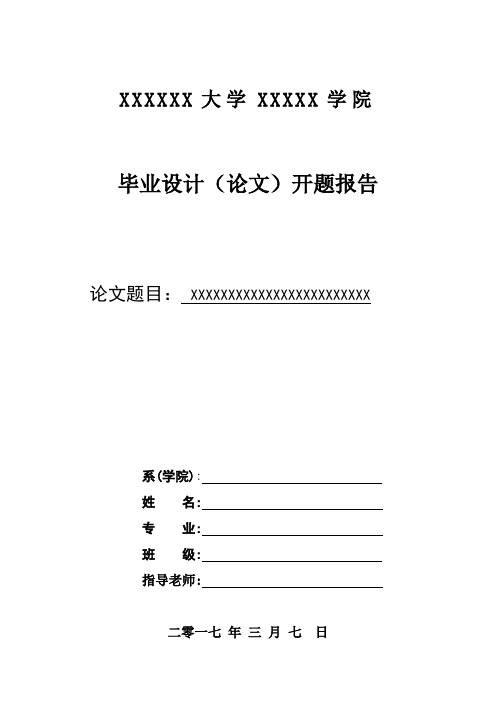
加强技术防护措施,建立网络漏洞监测和攻击防范系统。
预期效果:有条件的大型企业应立足于国际水准,培养或聘用一批掌握国际先进技术,精通信息技术,熟练应用会计电算化的高级技术人才,推动企业电算化事业由“核算型”向“管理型”、“智能型”转变。中小企业应积极支持和组织会计人员学习和提高会计电算化知识,掌握计算机先进技术,培养复合型人才,为尽快建立高效的会计信息系统创造条件。
姓名
学号
指导教师
所在教研室
一、设计()
目的:加强会计电算化系统的安全监控,切实防范电算化会计风险,严厉打击计算机犯罪。
意义:使财务会计和管理会计能更有效地互相结合、互相补充,充分发挥各自的职能优势,有助于企业加强管理,提高竞争能力,有助于强化技术安全管理、建立科学有效的制度保障机制和提高人员素质三个方面的措施,以防范电算化会计系统存在的安全风险。
参考文献:[1]XXXXXXXXXX;
[2]XXXXXXXXXXX;
[3]XXXXXXXXXXXXXX;
[4]XXXXXXXXXXXXXXX;
[5]XXXXXXXXXXXX。
二、设计(论文)主要研究的内容和方法
【内容提要】会计电算化影响了会计实践的方方面面,大大提高了会计信息处理的速度和准确性,为用户提供及时准确的会计信息,有助于企业加强管理,提高竞争能力。然而,就在会计电算化实现其强大功能的同时,电算化系统的安全问题也越来越来突出。本文提出了强化技术安全管理、建立科学有效的制度保障机制和提高人员素质三个方面的措施,以防范电算化会计系统存在的安全风险。
【方法】从技术上加强电算化系统的安全管理;建立科学有效的制度保障机制;
本科毕业论文模板范文

本科毕业论文模板范文本科毕业论文模板范文随着大学教育的普及和发展,本科毕业论文成为了每个本科生必须完成的一项任务。
本文将以一个模板范文的形式,为广大本科生提供一些参考和指导。
引言本科毕业论文是学生在大学期间的重要学术成果之一,也是对其专业知识和研究能力的综合考验。
本文将以某某学科作为研究对象,探讨其相关问题并提出解决方案。
一、研究背景本节将介绍某某学科的背景和重要性。
例如,某某学科在现代社会中的应用广泛,对人类社会的发展具有重要意义。
同时,本节还可以介绍该学科的发展历程和研究现状,为后续章节的内容做好铺垫。
二、研究目的与意义本节将明确本次研究的目的和意义。
例如,通过对某某学科的深入研究,可以揭示其内在规律,为相关领域的发展提供理论支持和实践指导。
同时,本节还可以阐述本次研究的创新点和研究价值,以及对学术界和实际应用的贡献。
三、文献综述本节将对相关领域的研究文献进行综述和分析。
通过对已有研究成果的梳理,可以了解该学科的研究现状和研究热点,为本次研究提供理论基础和参考依据。
同时,本节还可以对现有研究的不足之处进行评述,并提出本次研究的创新点和研究方向。
四、研究方法与设计本节将介绍本次研究的方法和设计。
例如,采用实证研究方法,通过问卷调查和实地观察收集数据,并运用统计分析方法进行数据处理和结果验证。
同时,本节还可以对研究对象的选择和样本的确定进行说明,以及研究过程的具体安排和步骤。
五、研究结果与分析本节将呈现本次研究的结果和分析。
通过对数据的整理和统计分析,可以得出具体的研究结果,并对结果进行深入解读和分析。
同时,本节还可以结合前人研究成果进行对比和讨论,以验证本次研究的可靠性和有效性。
六、结论与展望本节将总结本次研究的主要结论,并对未来的研究方向和发展趋势进行展望。
同时,本节还可以对本次研究的局限性和不足之处进行说明,并提出改进和完善的建议。
结语通过本文的模板范文,我们可以看到一个完整的本科毕业论文的结构和内容安排。
毕业论文_极限思想的产生与发展
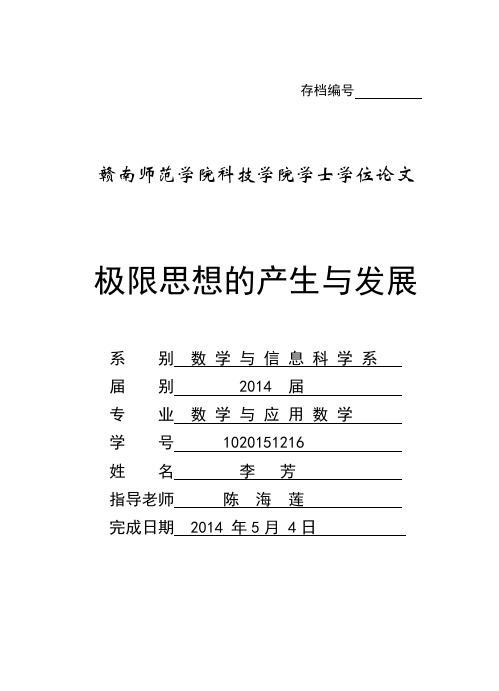
存档编号赣南师范学院科技学院学士学位论文极限思想的产生与发展系别数学与信息科学系届别 2014 届专业数学与应用数学学号 1020151216 姓名李芳指导老师陈海莲完成日期 2014 年5月 4日目录内容摘要 (1)关键词 (1)Abstract (1)Key words (1)引言 (2)1.极限思想的产生 (2)2.极限思想的发展 (4)3.极限思想的概念 (5)极限的现代定义 (5)3.2函数极限的性质 (6)数列极限存在的条件 (7)4 极限思想的应用 (8)极限思想在割圆术中的应用 (8)极限思想在开方方面中的应用 (8)极限思想在微积分中的应用 (10)极限思想在解题中的应用 (11)结论 (15)参考文献 (17)致谢 (18)内容摘要:本文主要论述极限思想的产生与发展、极限思想的概念、辩证与剖析及其应用。
极限思想是荷兰数学家斯泰文在考察三角形重心的过程中改进了古希腊人的穷竭法时产生的,他借助几何直观,大胆地运用极限思想思考问题,放弃了归谬法的证明,而牛顿,莱布尼兹对极限思想的建立作出了创造性的贡献。
本文最后探讨了极限思想在割圆术、开方、微积分和求解某一点方面的应用。
关键词:极限思想产生发展概念辩证剖析应用Abstract: This paper mainly discusses the origin and development of the limit idea, limit thought concept, dialectical analysis and its application. Limit thought is produced by Holland mathematician Steven improved the method of exhaustion of the ancient Greeks, while investigating the center of gravity when he, with the aid of the geometry, bold use of thinking about the limit, give up reductio ad absurdum proof, and Newton, made creative contribution to establish the Leibniz limit thought. This paper finally discusses the application of limit thought in cyclotomy, prescribing, calculus and solution of a point of.Key words: Limit thought production development concept dialectical analysis application引言数学是对现实世界数与形简洁的、高效的、优美的描述, 是有其内部抽象性和外部有效性的一门学科。
《赣南师范学院学位论文要求与写作指南》——(文科)

《赣南师范学院学士学位论文》写作指南(文科)毕业论文是本科教学计划的最后一个重要环节,是落实本科教育培养目标的重要组成部分。
其主要目的是培养学生综合运用所学知识和技能,理论联系实际,独立分析,解决实际问题的能力,使学生得到从事本专业工作的基本训练。
一、论文的结构内容本科学位论文应包括(1)中文封面;(2)中英文内容提要及关键词;(3)正文;(4)注释与参考文献等四大要素并按此顺序排列。
具体又包括:题目、摘要、引言、主体、结论、致谢、参考文献。
(一)论文题目论文题目是论文全貌的集中体现,应能概括整个论文最重要的内容,命题必须确切、简明,题目应力求简单,也不应宽泛笼统,应能看出论文的实质性内容和工作重心。
中文题名一般不超过20个汉字,必要时可加副题名。
副题名可另起一行,用破折号与主题名隔开。
题名中应避免使用非公知公用的缩略语、字符、代号以及结构式和公式。
(二)中文内容提要及关键词。
关键词:每篇论文关键词3-5个。
内容提要为论文主要观点、内容的整体概括。
摘要:摘要的写作要点:1、摘要是对研究过程和结论及其科学性的全面的概括性表述。
2、摘要内容一般包含研究问题、研究方法和结果/讨论。
3、摘要往往在文章写好后再写,每一句话大致代表正文每一部分的主题,但句与句之间要连贯一气。
4、摘要不能写成“简介”或“意义”,它们属于引言部分的内容。
5、摘要的字数控制在200字以内。
(三)引言引言的写法:1、引言主要包括问题的领域和研究背景。
2、陈述清楚所要研究的目的和问题概要。
3、说明研究方法。
4、说明研究的实践意义和理论意义。
(四)文献综述文献综述的写法:文献综述是对本问题国内外已有研究在研究主题、研究方法、研究结论等方面的概括性、批判性的介绍和评价,在此基础上,指出已有研究存在的问题和今后的研究方向,从而水到渠成地提出研究的问题。
1、没有一个值得研究的问题不需要文献综述,或者说找不到前人的相关研究。
2、注意对与自己不同的观点包括相反的观点进行客观的、符合逻辑的、就事论事的表述。
井冈山旅游淡旺季游客相差悬殊的原因及应对策略(毕业论文)

存档编号赣南师范学院学士学位论文井冈山旅游淡旺季游客相差悬殊的原因及应对策略教学学院历史文化与旅游学院届别2010 届专业旅游管理学号060202076姓名费保国指导教师袁继荣完成日期2009-10-27目录内容摘要 (1)关键词 (1)Abstract (1)Key words (1)一、井冈山旅游淡旺季游客相差悬殊的现状及问题 (2)(一)井冈山旅游淡旺季游客相差悬殊的现状 (2)(二)井冈山旅游淡旺季游客相差悬殊的问题 (2)二、井冈山旅游淡旺季游客相差悬殊的原因 (2)(二)井冈山旅游资源季节性强,旅游产品功能单一 (2)(二)井冈山旅游客源市场狭窄 (3)(三)井冈山旅游市场淡季营销意识不强 (4)(四)井冈山旅游服务质量欠缺,基础配套设施不完善 (4)三、井冈山旅游淡旺季游客相差悬殊的应对策略 (5)(一)强化旅游目的地品牌形象意识 (5)(二)开发特色旅游产品,优化淡季旅游产品结构 (6)(三)加强旅游信息发布,进行科学宣传促销 (7)(四)注重淡季客源市场开发,拓展旅游客源市场 (8)(五)改善旅游环境以优质的旅游环境吸引八方游客 (9)四、结语 (10)参考文献 (11)内容摘要:长期以来,井冈山旅游业存在明显的旅游淡旺季现象,特别是旅游淡季过淡,旺季过旺的现象,给旅游地的旅游资源、环境、社会、经济以及游客体验带来不良影响。
因而,如何协调井冈山旅游业淡旺季之间存在的明显差异和矛盾是一个亟待解决的问题。
本文从井冈山旅游淡旺季游客相差悬殊的现状出发,结合井冈山旅游淡旺季具体存在的问题,对旅游淡旺季产生的原因进行客观的分析并提出了相应的应对策略。
关键词:井冈山旅游;淡旺季;悬殊;应对策略Abstract:For a long time, there exists an obvious tourist tourism Jinggangshan seasonal phenomenon, in particular the tourist off-season too short, the phenomenon of overtaking supply season to give tourist places, tourism resources, environmental, social, economic and tourists to experience a negative impact. Thus, how to coordinate between Jinggangshan tourism, seasonal differences and the apparent contradiction is a serious problem。
赣南师范学院本科毕业论文(设计)写作与排版规范
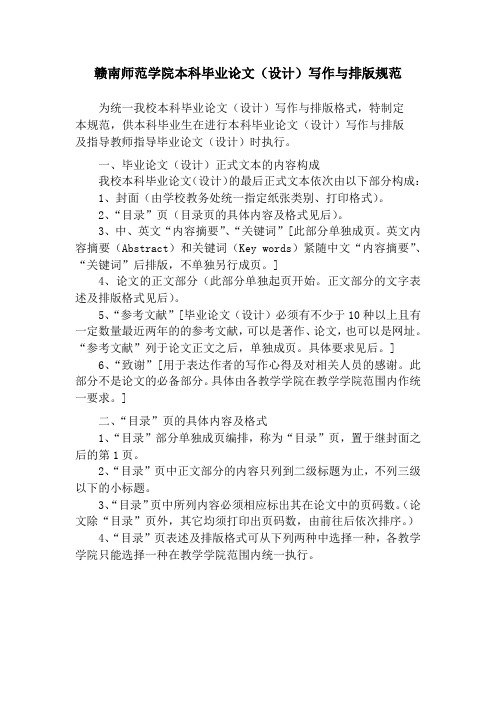
赣南师范学院本科毕业论文(设计)写作与排版规范为统一我校本科毕业论文(设计)写作与排版格式,特制定本规范,供本科毕业生在进行本科毕业论文(设计)写作与排版及指导教师指导毕业论文(设计)时执行。
一、毕业论文(设计)正式文本的内容构成我校本科毕业论文(设计)的最后正式文本依次由以下部分构成:1、封面(由学校教务处统一指定纸张类别、打印格式)。
2、“目录”页(目录页的具体内容及格式见后)。
3、中、英文“内容摘要”、“关键词”[此部分单独成页。
英文内容摘要(Abstract)和关键词(Key words)紧随中文“内容摘要”、“关键词”后排版,不单独另行成页。
]4、论文的正文部分(此部分单独起页开始。
正文部分的文字表述及排版格式见后)。
5、“参考文献”[毕业论文(设计)必须有不少于10种以上且有一定数量最近两年的的参考文献,可以是著作、论文,也可以是网址。
“参考文献”列于论文正文之后,单独成页。
具体要求见后。
]6、“致谢”[用于表达作者的写作心得及对相关人员的感谢。
此部分不是论文的必备部分。
具体由各教学学院在教学学院范围内作统一要求。
]二、“目录”页的具体内容及格式1、“目录”部分单独成页编排,称为“目录”页,置于继封面之后的第1页。
2、“目录”页中正文部分的内容只列到二级标题为止,不列三级以下的小标题。
3、“目录”页中所列内容必须相应标出其在论文中的页码数。
(论文除“目录”页外,其它均须打印出页码数,由前往后依次排序。
)4、“目录”页表述及排版格式可从下列两种中选择一种,各教学学院只能选择一种在教学学院范围内统一执行。
格式一:(建议文科教学学院采用此格式)目录(居中,宋体小二号,加黑)1关键词………………………………………………………AbstractKey words××××(二级标题)……………………………………二)××××…………………………………………………××……………………………………………………二、××……………………………………………………××……………………………………………………一)××××…………………………………………………二)××××…………………………………………………三)××××…………………………………………………致谢……………………………………………………………[说明:在本页中,除“目录”二字外,其它统一由宋体小四号排版打印] 格式二:(建议理科教学学院采用此格式)目录(居中,宋体小二号,加黑)内容摘要 (1)关键Abs tra ct…………………………………………………………Key words1.1.1××××(二级标题)………………………………………1.2××××………………………………………………………1.3××××…………………………………………………………22.1××××………………………………………2.2××××………………………………………………………2.3××××……………………………………………………3.3.1××××………………………………………………………3.2××××………………………………………………………3.3××××…………………………………………………………致[说明:在本页中,除“目录”二字外,其他统一由宋体小四号排版打印]三、中、英文“内容摘要”、“关键词”部分的内容及格式要求1.这一部分包括(中文的)“内容摘要”、“关键词”和相应的英文的“Abstract”、“Key words”四个部分,依次在同一页中排版打印,一页不够的,可以顺延下一页。
本科毕业论文模板【范本模板】

长沙学院 高等教育自学考试本科生毕业论文浅析《庄子》中畸人形象的美学价值系 (部):× × × × × ×(宋体4号)专 业:× × × × × ×(宋体4号)学 号:× × × × × ×(宋体4号)学生姓名:× × ×(宋体4号)指导教师:× × ×(宋体4号)200 年 月(2号宋体居中)(2黑体居中)长沙学院毕业设计(论文)摘 要(空一行) ××××××××××××××××(小四号宋体,行距20磅,首行缩进2字符)×××××××××××××××××××××××××××××××××××××××××××××××××××××××××××××××××××××××××××××××××××××××××××××××××××××××××××××××××××××××××××××××××××××××××××××××××××××××××××××××××××××××××××××××××××××××××××××××××××.(要求300字左右)(1)用精炼、概括的语言来表达,每项内容不宜展开论证或说明,要客观陈述,不宜加主观评价;(2)结果和结论性字句是摘要的重点,在文字论述上要多些,以加深读者的印象;(3)要独立成文,选词用语要避免与全文尤其是前言和结论部分雷同;(4)摘要中不宜使用公式、图表,不标注引用文献编号。
师范学院本科生毕业论文格式范文荐读
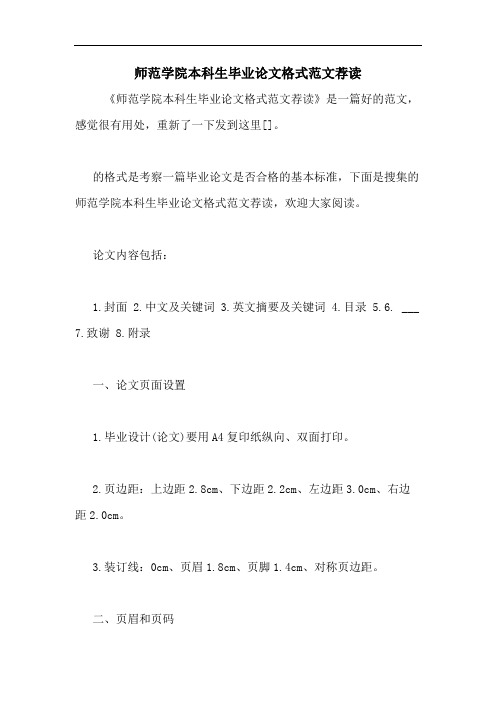
师范学院本科生毕业论文格式范文荐读《师范学院本科生毕业论文格式范文荐读》是一篇好的范文,感觉很有用处,重新了一下发到这里[]。
的格式是考察一篇毕业论文是否合格的基本标准,下面是搜集的师范学院本科生毕业论文格式范文荐读,欢迎大家阅读。
论文内容包括:1.封面2.中文及关键词3.英文摘要及关键词4.目录5.6. ___7.致谢8.附录一、论文页面设置1.毕业设计(论文)要用A4复印纸纵向、双面打印。
2.页边距:上边距2.8cm、下边距2.2cm、左边距3.0cm、右边距2.0cm。
3.装订线:0cm、页眉1.8cm、页脚1.4cm、对称页边距。
二、页眉和页码1.页眉:奇数页:论文题目;偶数页:广东技术师范学院本科毕业设计(论文)。
居中。
2.页码:从绪论部分开始,至附录,用阿拉伯数字连续编排,页码位于页脚右侧。
封面、中英文设计说明(论文摘要)和目录不编入论文页码。
请采用封面模板,下载后添加自己的信息。
四、论文摘要和关键词1.中文的论文题目二号黑体,加粗,居中,段前段后1行。
2.中文摘要和关键词(1)摘要:两字(三号黑体,加粗)。
段前段后1行。
独立一行,居中。
(2)摘要正文:小四号宋体,1.5倍行距。
摘要正文后下空一行。
(3)关键词:三字(四号黑体,加粗)。
段前空两个字符。
(4)关键词正文:一般为3~5个,小四号宋体,1.5倍行距。
每一关键词之间用分号隔开,最后一个关键词后不打标点符号。
3.英文的论文题目另起一页,二号Times New Roman体,加粗,居中,段前段后1行。
4.英文摘要和关键词英文和汉语拼音一律为Times New Roman体,格式、字号与中文摘要相同。
1.目录:两字(三号黑体,加粗)。
段前段后1行。
独立一行,居中。
2.目录正文:使用插入/引用/索引和目录菜单中的目录项,选择各级标题设置(标题1、标题2、标题3)。
目录中各章题序的阿拉伯数字用Times New Roman体,第一级标题用小四号黑体,其余用小四号宋体。
2017年赣南师范学院本科格式模板
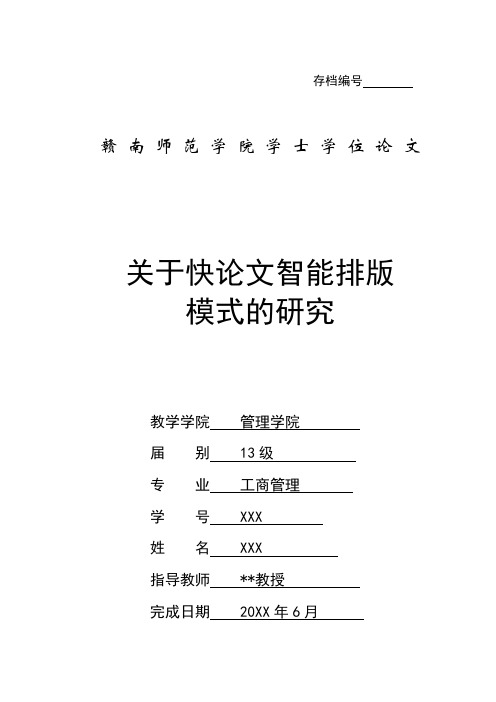
存档编号赣南师范学院学士学位论文关于快论文智能排版模式的研究教学学院管理学院届别 13级专业工商管理学号 XXX姓名 XXX指导教师 **教授完成日期 20XX年6月目录内容摘要.........................................................................................错误!未定义书签。
关键词.............................................................................................错误!未定义书签。
Abstract....................................................... 错误!未定义书签。
错误!未定义书签。
Key words.. (I)一、绪论 (1)(一)快论文的选题背景 (1)(二)国内外研究现状 (1)(三)创新点和技术路线 (2)(四)本章小结 (2)二、快论文一键排版的基本原理 (3)(一)快论文一键排版概述 (3)(二)智能排版的准确性分析 (3)(三)快论文排版的快速性分析 (3)(四)本章小结 (3)三、基于人工智能的快论文排版系统设计 (4)(一)快论文排版系统的设计方案 (4)(二)快论文平台的功能介绍 (4)(三)本章小结 (6)四、快论文平台的人性化设计 (7)(一)模板选择界面的设计 (7)(二)论文编辑界面的设计 (7)(三)本章小结 (8)五、系统应用实例 (9)(一)快论文系统的使用方法 (9)(二)本章小结 (11)参考文献 (12)致谢 (13)一款专业的毕业论文在线排版系统,上传论文草稿,选定学校模板,点击一键排版,只需几分钟就可完成论文排版,免费下载预览,满意后付款。
快论文平台现已汇集了全国617所高校权威毕业论文模板,均源自各校官方最新发布的毕业论文撰写规范,基本涵盖了各类高校毕业论文格式要求。
- 1、下载文档前请自行甄别文档内容的完整性,平台不提供额外的编辑、内容补充、找答案等附加服务。
- 2、"仅部分预览"的文档,不可在线预览部分如存在完整性等问题,可反馈申请退款(可完整预览的文档不适用该条件!)。
- 3、如文档侵犯您的权益,请联系客服反馈,我们会尽快为您处理(人工客服工作时间:9:00-18:30)。
赣南师范学院本科生毕业论文写作模板
存档编号
赣 南
师 范 学 院 学 士 学 位
题
教学学院 届 别 专 业 学 号 姓 名 指导教师 完成日期
作者声明
本毕业论文(设计)是在导师的指导下由本人独立撰写完成的,没有剽窃、抄袭、造假等违反道德、学术规范和其他侵权行为。
对本论文(设计)的研究做出重要贡献的个人和集体,均已在文中以明确方式标明。
因本毕业论文(设计)引起的法律结果完全由本人承担。
毕业论文(设计)成果归赣南师范学院所有。
特此声明。
作者专业:XXXXXX
作者学号:XXXXXXXXX
作者签名:XXX(手写有效)
20XX年X 月XX日(手填时间)
毕业论文(设计)中文题目(二号黑体,居中)作者中文姓名(三号宋体,加粗,居中)
毕业论文(设计)英文题目(二号“新罗马体(Times New Roman)”半角字符,斜体,居
中。
)
作者英文姓名(三号“新罗马体(Times New Roman)”半角
字符,加粗,居中)
XXXX年X月X日(毕业论文完成时间,三号宋体,加粗,段
后空两行,与签名居中对齐)
摘要
(中文摘要正文,300字左右。
宋体,小四,1.25倍行距)
关键词:(3-5个关键词,小四号宋体,其间用分号“;”分隔)
Abstract
(英文摘要正文,“新罗马体(Times New Roman)”半角字符,小四,1.25倍行距)
Key words: (各个关键词用小四号字体,其间用英文状态下的分号“;”分隔。
第一个关键词的第一个字母大写,)
目 录
(1)
关 键
词 (1)
Abstract ………………………………………………………………………
1
Key words (1)
.××××(一级标题)............................................................××××(二级标题)............................................................××××..............................................................................××××...............................................................................×××××...........................................................................××××..............................................................................×××× ...........................................................................×××× ............................................................................××××× ........................................................................××××...........................................................................×××× ...........................................................................×××× ........................................................................... 录 (19)
后 记 (22)
致 谢 (23)
[说明:在本页中,除“目录”二字外,其他统一由宋体小四号排版打]
论文正文
论文正文部分包括引论(或导论、绪论)、论文主体及结语(或结论)三个主要部分,总字数5000-10 000字为宜(理科和特殊专业的毕业设计以2000字以上为宜)。
中文用宋体,小四,1.25倍行距
论文中所有英文大、小写一律用“新罗马体(Times New Roman)”半角字符。
论文中所有中文表述内的标点符号应当统一用全角状态下的字符;而所有英文间的标点符号则统一用半角字符,但均应在标点符号后加一空格。
论文中凡是涉及阿拉伯数字的一律用半角字符(如12345),而不宜用全角字符(如12345)。
版面规格。
毕业论文用A4纸,一般为纵向排版,双面打印,左边装订。
页面设置。
正文版面设置基本限定值如下:页边距为上3cm、下2.5㎝、左3cm、右2.5cm;正文字体为小四号宋体;全部文本的基本行间距统一设为1.25倍(word 软件中“格式——段落——多倍行距——设置值1.25”即可),部分地方按本规范的特殊要求处理。
页眉设置。
页眉统一标示“赣南师范学院XXXX届本科生毕业论文(设计)”字样,小五号字,宋体,居中,“届次”必须用阿拉伯数码字标示。
封面不设页眉。
页脚设置。
论文正文的页脚,从“导论”部分开始,直到“后记”部分为止,连续采用“1”、“2”、“3”……等阿拉伯数字顺序编号标示页码,左右各加一连字符“-”,小五号字,宋体,如“-1-”(可自动插入),居中排列。
此外,“作者声明”与“论文(设计)题目及署名”不设页脚,“中文摘要及关键词”、“外(英)文摘要及关键词”和“目录”的页脚设置要求均同正文,但各自起序,互不连续。
赣南师范学院2014届本科生毕业论文(设计)
- 2 -。
